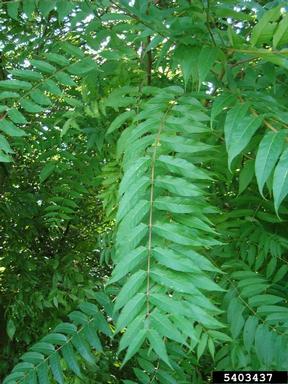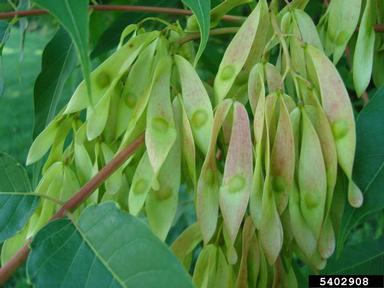-
-
-
-
-
-
-
-
-
-
-
-
-
-
-
Tree of Heaven
-
-
-
-
-
-
|
Tree of Heaven
Ailanthus altissima (Mill.) Swingle
[ Excerpted from the "Invasive Plants Field and Reference Guide" by the USDA Forest Service, NA-TP-05-04, 7/07 ]
Habit: Deciduous tree to 30 m (98 ft) in height.
Reproduction: By seed and vegetatively via root suckering.

Leaves: Pinnately compound to 1 m (3 ft) in length with 11-41 leaflets, each with a ‘thumb’ or lobe at the base; leaflet teeth have glands.
Stems: Bark gray and smooth; younger twigs covered with a light brown to reddish brown pubescence; thick or chubby tips; may grow up to 2 m (61⁄2 ft) in one season.
Flowers: Dioecious; hermaphrodites exist; bloom June to July; may flower as early as 6 weeks after germination; typically insect pollinated by a variety of pollinators, including bees.
Fruits/Seeds: Two-winged samara (180º) with one central seed; sets late summer; over 300,000 seeds per tree documented; seeds may remain on the tree through winter; wind dispersed; cold stratification not required for germination; seed bank formation thought unlikely, though found as part of an urban forest seed bank.

Habitat: Native to China; several introductions into the U.S. since 1784; found in poor and rich soil on steep and shallow slopes, urban areas, open fields and woodlands, and closed canopy forests; often associated with disturbed habitats; USDA hardiness zones 4-8.
Comments: Extensive cloning; at least 5 cultivars; crushed leaves, stems, and roots smell of rancid peanut butter; allelopathic properties present, though negative effects may be less severe if previously exposed; tolerant of several air pollutants; seedlings are drought resistant; quassinoid compounds may deter some insect herbivory and frugivory, but seeds and tissue may be preyed upon by deer, mice, and voles, even preferentially in the case of some invertebrates.
Similar Native Species: Sumacs (Rhus glabra, R. typhina); walnuts (Juglans nigra, J. cinerea); none of the crushed leaves or broken stems of these have the same odor; fruits not samaras.
Photos: Annemarie Smith, ODNR Division of Forestry, Bugwood.org


